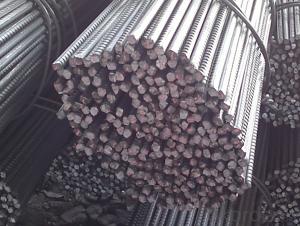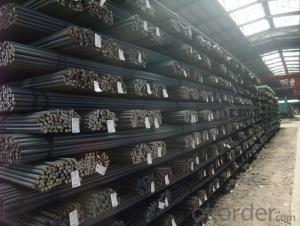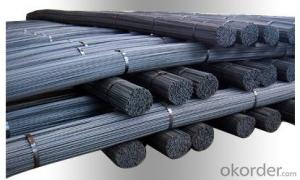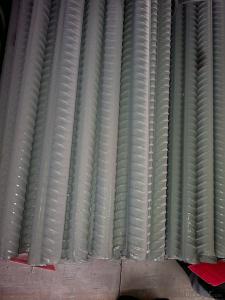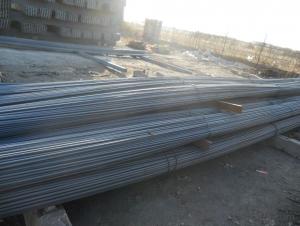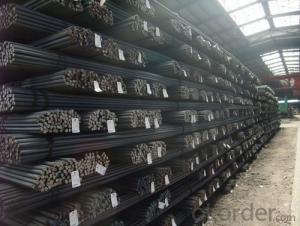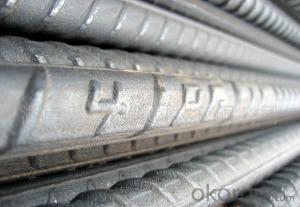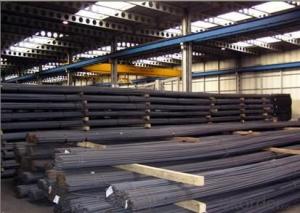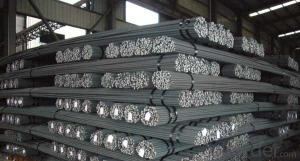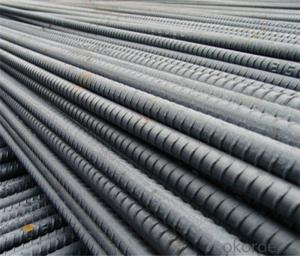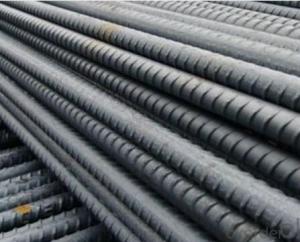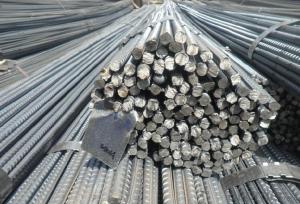A615 deformed steel bars for construction
- Loading Port:
- Tianjin
- Payment Terms:
- TT or LC
- Min Order Qty:
- 25 m.t.
- Supply Capability:
- 100000 m.t./month
OKorder Service Pledge
OKorder Financial Service
You Might Also Like
Product Description:
OKorder is offering A615 deformed steel bars for construction at great prices with worldwide shipping. Our supplier is a world-class manufacturer of steel, with our products utilized the world over. OKorder annually supplies products to European, North American and Asian markets. We provide quotations within 24 hours of receiving an inquiry and guarantee competitive prices.
Product Applications:
A615 deformed steel bars are ideal for structural applications and are widely used in the construction of buildings and bridges, and the manufacturing, petrochemical, and transportation industries.
Product Advantages:
OKorder's deformed steel bars are durable, strong, and resist corrosion.
Main Product Features:
· Premium quality
· Prompt delivery & seaworthy packing (30 days after receiving deposit)
· Corrosion resistance
· Can be recycled and reused
· Mill test certification
· Professional Service
· Competitive pricing
Product Specifications:
Specifications of HRB400 Deformed Steel Bar:
Standard | GB | HRB400 | |
Diameter | 6mm,8mm,10mm,12mm,14mm,16mm,18mm,20mm, 22mm,25mm,28mm,32mm,36mm,40mm,50mm | ||
Length | 6M, 9M,12M or as required | ||
Place of origin | Hebei, China mainland | ||
Advantages | exact size, regular package, chemical and mechanical properties are stable. | ||
Type | Hot rolled deformed steel bar | ||
Brand name | DRAGON | ||
Chemical Composition: (Please kindly find our chemistry of our material based on HRB500 as below for your information)
Grade | Technical data of the original chemical composition (%) | ||||||
C | Mn | Si | S | P | V | ||
HRB400 | ≤0.25 | ≤1.60 | ≤0.80 | ≤0.045 | ≤0.045 | 0.04-0.12 | |
Physical capability | |||||||
Yield Strength (N/cm²) | Tensile Strength (N/cm²) | Elongation (%) | |||||
≥400 | ≥570 | ≥14 | |||||
Theoretical weight and section area of each diameter as below for your information:
Diameter(mm) | Section area (mm²) | Mass(kg/m) | Weight of 12m bar(kg) |
6 | 28.27 | 0.222 | 2.664 |
8 | 50.27 | 0.395 | 4.74 |
10 | 78.54 | 0.617 | 7.404 |
12 | 113.1 | 0.888 | 10.656 |
14 | 153.9 | 1.21 | 14.52 |
16 | 201.1 | 1.58 | 18.96 |
18 | 254.5 | 2.00 | 24 |
20 | 314.2 | 2.47 | 29.64 |
22 | 380.1 | 2.98 | 35.76 |
25 | 490.9 | 3.85 | 46.2 |
28 | 615.8 | 4.83 | 57.96 |
32 | 804.2 | 6.31 | 75.72 |
36 | 1018 | 7.99 | 98.88 |
40 | 1257 | 9.87 | 118.44 |
50 | 1964 | 15.42 | 185.04 |
Usage and Applications of HRB400 Deformed Steel Bar:
Deformed bar is widely used in buildings, bridges, roads and other engineering construction. Big to highways, railways, bridges, culverts, tunnels, public facilities such as flood control, dam, small to housing construction, beam, column, wall and the foundation of the plate, deformed bar is an integral structure material. With the development of world economy and the vigorous development of infrastructure construction, real estate, the demand for deformed bar will be larger and larger..
Packaging & Delivery of HRB400 Deformed Steel Bar:
Packaging Detail: products are packed in bundle and then shipped by container or bulk vessel, deformed bar is usually naked strapping delivery, when storing, please pay attention to moisture proof. The performance of rust will produce adverse effect.
Each bundle weight: 2-3MT, or as required
Payment term: TT or L/C
Delivery Detail: within 45 days after received advanced payment or LC.
Label: to be specified by customer, generally, each bundle has 1-2 labels
Trade terms: FOB, CFR, CIF

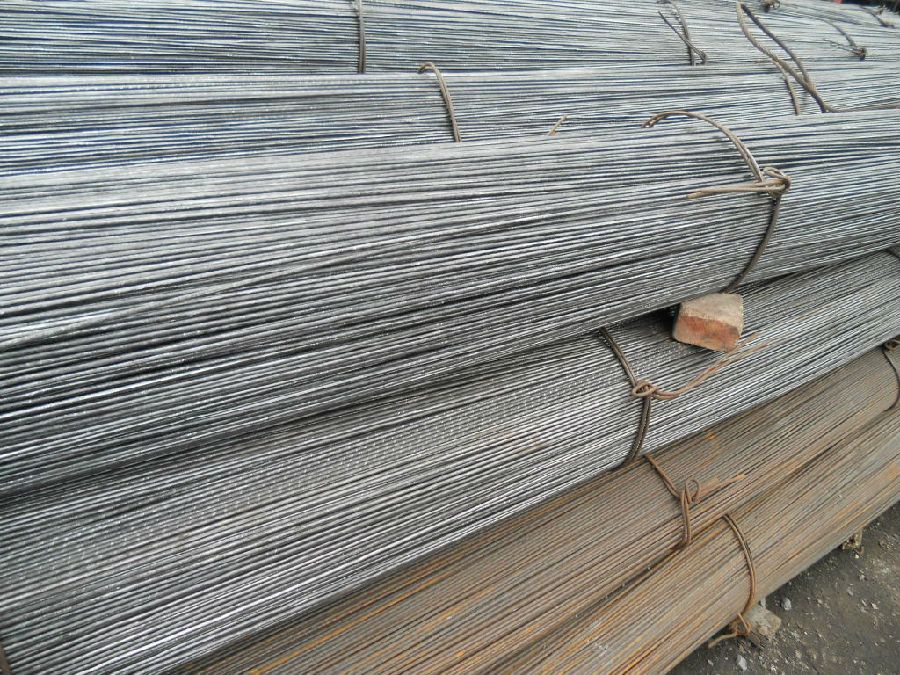

FAQ:
Q1: What makes stainless steel stainless?
A1: Stainless steel must contain at least 10.5 % chromium. It is this element that reacts with the oxygen in the air to form a complex chrome-oxide surface layer that is invisible but strong enough to prevent further oxygen from "staining" (rusting) the surface. Higher levels of chromium and the addition of other alloying elements such as nickel and molybdenum enhance this surface layer and improve the corrosion resistance of the stainless material.
Q2: Can stainless steel rust?
A2: Stainless does not "rust" as you think of regular steel rusting with a red oxide on the surface that flakes off. If you see red rust it is probably due to some iron particles that have contaminated the surface of the stainless steel and it is these iron particles that are rusting. Look at the source of the rusting and see if you can remove it from the surface.
- Q: How do steel rebars affect the overall weight of a construction project?
- The overall weight of a construction project can be significantly influenced by steel rebars. These rebars, commonly used to strengthen concrete structures like beams, columns, and foundations, enhance durability and strength. Due to the high-strength steel used in their production, steel rebars add considerable weight to the project. Various aspects of the construction project are affected by the weight of steel rebars. During the design phase, it is crucial to consider the total weight of the rebars to ensure that the structure can bear the additional load. This is especially important for constructing high-rise buildings or structures requiring substantial reinforcement. Transportation and logistics are also impacted by the weight of steel rebars. As these rebars are usually delivered to the construction site in large quantities, their weight influences the choice of transportation methods, such as trucks or cranes, and may necessitate special permits or equipment. Moreover, the weight of rebars increases transportation costs. Furthermore, the weight of the construction project has implications for foundation requirements. The heavier the structure, the stronger the foundation needs to be in order to adequately support and distribute the load. This may lead to the necessity of deeper or wider foundations, resulting in increased costs and construction time. Lastly, the weight of steel rebars affects the overall sustainability of the construction project. Steel production involves significant energy consumption and emissions, so the increased weight of rebars contributes to a higher carbon footprint. Therefore, it is crucial for construction projects to strike a balance between reinforcement needs and environmental considerations. In conclusion, the weight of steel rebars has a tangible impact on the overall weight of a construction project. It influences design, transportation, foundation requirements, and sustainability. Architects, engineers, and project managers must carefully assess the weight of steel rebars to ensure structural integrity and construction project efficiency.
- Q: How do steel rebars reinforce concrete?
- The structural stability of concrete is reinforced by steel rebars, which provide additional strength. Concrete possesses strength under compression but is weak when subjected to tension. To counteract this weakness and enhance its tensile strength, steel rebars are embedded in the concrete. The rebars function as reinforcement by absorbing the tensile forces that arise when a structure undergoes bending or stretching. In the presence of such forces, the rebars evenly distribute the load across the concrete, preventing cracks and failure. This is particularly crucial in buildings, bridges, and dams, where the concrete must withstand diverse external forces. Furthermore, the rebars help regulate the expansion and contraction of the concrete resulting from temperature changes. Since steel and concrete have similar coefficients of thermal expansion, steel rebars assist in minimizing stress caused by temperature fluctuations, thus reducing the likelihood of cracking. Additionally, the bond between the steel rebars and the concrete is vital for effective reinforcement. The rough surface of the rebars ensures excellent adherence to the surrounding concrete, enabling them to function as a composite material. This bond facilitates the transfer of stress from the concrete to the rebars, thereby enhancing the overall strength and durability of the structure. To summarize, steel rebars reinforce concrete by providing tensile strength, distributing loads, controlling temperature-induced stress, and establishing a robust bond with the concrete. The combination of concrete and steel results in a reinforced concrete structure capable of withstanding various external forces and maintaining its structural integrity over time.
- Q: Are steel rebars suitable for use in aggressive environments?
- Yes, steel rebars are suitable for use in aggressive environments. Steel rebars are commonly used in construction projects, including those in aggressive environments such as coastal areas, chemical plants, and wastewater treatment facilities. They possess excellent durability, strength, and corrosion resistance properties, making them highly suitable for withstanding aggressive elements like saltwater, chemicals, and moisture. Additionally, proper protective coatings can be applied to enhance their resistance to corrosion, ensuring their long-term performance in aggressive environments.
- Q: What are the weight and density of steel rebars?
- Steel rebars, also known as reinforcing bars, are commonly utilized in construction to impart tensile strength to concrete structures. The weight and density of steel rebars may differ depending on their size and grade. The weight of a steel rebar is determined by its cross-sectional area and the specific weight of steel, which is roughly 7850 kilograms per cubic meter (or 0.2836 pounds per cubic inch). The cross-sectional area is usually quantified in square millimeters or square inches. For instance, a prevalent size of steel rebar is the #4 bar, possessing a diameter of 12.7 millimeters (or 0.5 inches) and a cross-sectional area of 127 square millimeters (or 0.197 square inches). By employing the specific weight of steel, we can compute the weight of a #4 rebar in the following way: Weight = Cross-sectional area x Specific weight of steel Weight = 127 mm^2 x 7850 kg/m^3 Weight = 998,950 grams or approximately 998.95 kilograms (or 2,201 pounds) Concerning density, the density of steel rebars coincides with the specific weight of steel, which is roughly 7850 kilograms per cubic meter. This density remains relatively consistent across diverse sizes and grades of steel rebars. It is important to acknowledge that the weight and density of steel rebars may slightly fluctuate based on the precise composition and manufacturing process. It is therefore prudent to refer to the manufacturer's specifications or consult engineering references for precise and up-to-date information.
- Q: How do steel rebars affect the thermal conductivity of concrete?
- Steel rebars have a negligible effect on the thermal conductivity of concrete, as they conduct heat at a much higher rate than concrete.
- Q: Can steel rebars be used in structures with aggressive chemical exposure?
- Steel rebars can be used in structures with aggressive chemical exposure, but their performance may be compromised depending on the specific chemicals involved. It is crucial to select the appropriate type of steel with corrosion-resistant properties or use protective coatings to prevent degradation and maintain structural integrity. Additionally, regular maintenance and monitoring are required to ensure the rebars' durability in such environments.
- Q: How are steel rebars protected against chemical attacks?
- Steel rebars are typically protected against chemical attacks through the use of protective coatings or by incorporating corrosion inhibitors in the concrete mix. These measures act as barriers, preventing corrosive elements from reaching and damaging the steel rebars.
- Q: Are there any limitations on the maximum length of steel rebars used in construction?
- Yes, there are limitations on the maximum length of steel rebars used in construction. The maximum length of steel rebars can vary depending on various factors such as the structural design, construction codes, and transportation limitations. In general, the length of steel rebars is limited by practical considerations such as handling, transportation, and installation. Very long rebars can be difficult to transport and maneuver on construction sites. Additionally, excessively long rebars may be more prone to bending or sagging, which can affect their structural integrity. Therefore, construction industry standards and codes typically provide guidelines or restrictions on the maximum length of steel rebars to ensure their safe and efficient use in construction projects. It is important for architects, engineers, and contractors to adhere to these limitations to ensure the structural stability and safety of the building.
- Q: Can steel rebars be used in structures with limited construction regulations?
- Yes, steel rebars can be used in structures with limited construction regulations. Steel rebars are commonly used in construction due to their high tensile strength and durability. However, it is important to note that even in structures with limited regulations, it is crucial to follow basic safety guidelines and ensure proper engineering and construction practices to ensure the structural integrity and safety of the building.
- Q: How do steel rebars improve the structural integrity of concrete?
- Steel rebars improve the structural integrity of concrete in several ways. First and foremost, they enhance the tensile strength of concrete, which is otherwise weak in tension. Concrete has excellent compressive strength but lacks the ability to withstand pulling or stretching forces. By inserting steel rebars into the concrete, the tensile strength of the entire structure is significantly increased. The steel rebars act as reinforcement by distributing the stress and load across a wider area, preventing cracks and fractures from propagating through the concrete. They provide a strong bond between the concrete and the reinforcement, allowing the structure to bear heavy loads and resist bending, shearing, and other forces that can compromise its stability. Additionally, steel rebars help to control and mitigate the effects of shrinkage and thermal expansion and contraction that occur in concrete. These phenomena can often lead to cracking and structural damage. The steel rebars help to restrain the movement of the concrete, reducing the risk of cracks forming and ensuring the overall integrity of the structure. Furthermore, steel rebars increase the durability and longevity of concrete structures. They have high resistance to corrosion, which is especially important in environments with high moisture, chemicals, or saltwater exposure. The presence of steel rebars protects the concrete from deterioration and extends the lifespan of the structure. In summary, steel rebars play a crucial role in improving the structural integrity of concrete by enhancing its tensile strength, distributing stress and loads, preventing cracks, controlling shrinkage, resisting bending and shearing forces, and increasing durability. They provide a reliable and effective reinforcement system that ensures the stability and longevity of concrete structures.
Send your message to us
A615 deformed steel bars for construction
- Loading Port:
- Tianjin
- Payment Terms:
- TT or LC
- Min Order Qty:
- 25 m.t.
- Supply Capability:
- 100000 m.t./month
OKorder Service Pledge
OKorder Financial Service
Similar products
Hot products
Hot Searches
Related keywords
